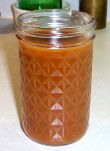Eastern North Carolina Vinegar-Based Barbecue Sauce
http://teriskitchen.com/sauces-recipes/eastern-north-carolina-barbecue-sauce.htmlMake in any amount (see comments below)
In Pennsylvania where I grew up, barbecue sauce used for pork has a tomato base, as in the similar and related recipes. My first experience with pork barbecue in a restaurant in eastern North Carolina was shocking. I thought that the sauce had turned sour. Then I went to my first pig-picking and discovered the real thing. It is so good. Nothing can compare to the flavor of a tender, juicy piece of pork slow-roasted over wood coals and basted with a vinegar and spice sauce. It is so delicious. However, since pig-pickings are a rare occurrence, I wanted to try to make the sauce myself. After much research, I found a version in a Jeff Smith cookbook upon which this recipe is based. You will note the large amount of sauce the recipe yields. It can be reduced to any amount desired, as in the example provided. However, you can store extra sauce in the refrigerator for at least one week or in the freezer for up to one year. Alternately, if you are experienced in preserving, it can be canned using proper preserving methods. That also makes for nice homemade gifts. If using with pork, the meat can either be prepared in a slow-cooker or, my favorite, slow-roasted in the oven or covered grill, as in the similar and related recipes. This sauce is equally good on chicken
Ingredients
To make 8 quarts
- 1-1/2 cups dark brown sugar
- 1-1/2 cups Worcestershire sauce
- 1-1/2 cups yellow prepared mustard
- 1 quart ketchup
- 1/2 cup freshly ground black pepper, more or less to taste (see notes below)
- 1/2 cup crushed red pepper flakes, more or less to taste (see notes below)
- 3 quarts apple cider vinegar
- 2 quarts water
- 1 quart white wine
- 2 teaspoons liquid smoke (optional)
- 1/2 cup salt, more or less to taste (see notes below)
To make 1-1/3 quarts
- 1/4 cup dark brown sugar
- 1/4 cup Worcestershire sauce
- 1/4 cup yellow prepared mustard
- 2/3 cup ketchup
- 1 tablespoon freshly ground black pepper, more or less to taste (see notes below)
- 1 tablespoon crushed red pepper flakes, more or less to taste (see notes below)
- 1 pint apple cider vinegar
- 1-1/3 cups water
- 2/3 cup white wine
- 1/4 teaspoon liquid smoke (optional)
- 1 tablespoon salt, more or less to taste (see notes below)
Place all ingredients in a very large stock pot, or a saucepan for the smaller amount, and bring to a boil. Reduce heat, cover and simmer for about 30 minutes. Cool, then store in refrigerator until use.
Notes: The amount of black and red pepper called for in this recipe results in a fairly spicy-hot sauce. You might want to start with less and add more after tasting. Also, I use much less salt since some of the ingredients are high in sodium and I do not care for salty foods. Again, start with less and add more if needed.
 http://teriskitchen.com
http://teriskitchen.com